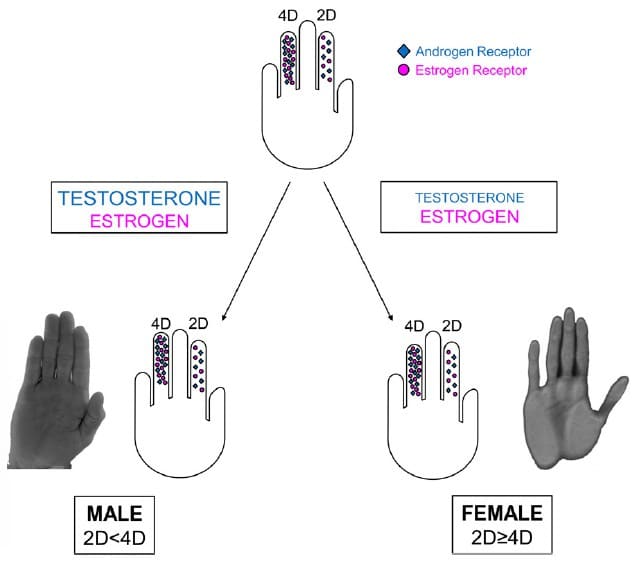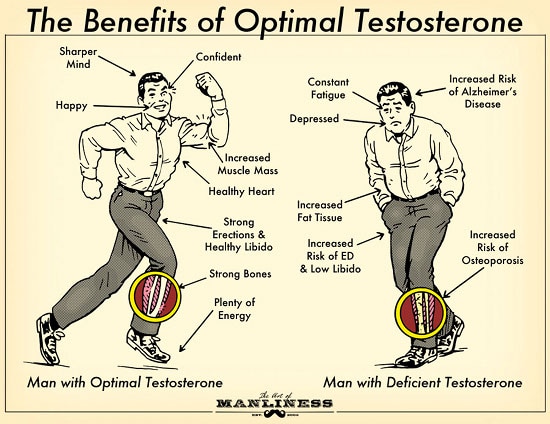Stop what you’re doing and look at your hands.
Is your ring finger longer than your index finger?
If so, you were likely exposed to higher levels of testosterone while you were in your mother’s womb.
Is your index finger longer than your ring finger?
Then you were exposed to lower levels of T as a fetus.
So what?
Well, while it might sound like hokey palm reading, researchers are finding that the ratio between the length of your ring and index fingers may in fact correlate to your prenatal exposure to T, and have a significant influence on your body, brain, and behavior well into adulthood.
How strong is this correlation and what exactly does it foretell? I’ve dived deep into all the available research to sort myth from fact, and present this comprehensive look at what digit ratio really means for your masculinity.
Prenatal Testosterone, Androgen Receptors, and 2D:4D Finger Ratios
Scientists have long noticed that men’s ring fingers are generally longer than their index fingers. With women, it tends to be the reverse: their index fingers are usually longer. They’ve called this difference in length between the index finger and ring finger the “2D:4D ratio.”
2D stands for “second digit” — that’s your index finger, and 4D means “fourth digit” — your ring finger. So if your index finger is 2.9 inches long and your ring finger is 3.1 inches long, you have a 2D:4D ratio of .935 (2.9/3.1 = .935). A longer ring finger compared to your index finger is considered a “low 2D:4D ratio.”
If your index finger is 3.1 inches long and your ring finger is 2.9 inches long, your 2D:4D ratio would be 1.06 (3.1/2.9 = 1.06). A longer index finger compared to your ring finger is considered a “high 2D:4D ratio.”
Digit ratios lie on a spectrum. Some men have really low digit ratios, like .83, and some folks have really high digit ratios, like 1.06.
The Connection Between 2D:4D Ratio and Prenatal Hormones
While scientists during the mid-20th century were able to statistically establish this general difference between men’s and women’s 2D:4D ratios, it wasn’t until the 1980s that researchers began speculating as to why this sex difference exists and how 2D:4D ratios may correlate with different gender traits. Dr. Glenn Wilson of King’s College was one of the first to hypothesize that 2D:4D finger ratio was determined by sex hormone exposure in the womb.
In 1998, further strides were made when psychologist John Manning of the University of Liverpool (now at Swansea University) published a paper in which he hypothesized that 2D:4D ratios are determined by prenatal exposure to testosterone. Other researchers came to similar conclusions using corollary evidence.
It wasn’t until 2011, however, that scientists were able to directly show that prenatal exposure to testosterone determines the 2D:4D ratio. While prenatal testing and studies are difficult-to-impossible to ethically conduct on human fetuses, the general difference between 2D:4D ratios in human males and females also exists between the sexes of other animals. Consequently, animal studies can provide insight into why these general differences exist.
Developmental biologists Martin Cohn and Zhengui Zheng conducted experiments on fetal mice in which they modified the amounts of testosterone they were exposed to in utero. What they discovered is that it’s not just the amount of fetal testosterone that determines digit ratio, but rather the balance between testosterone and estrogen. Mice with higher testosterone concentrations or low estrogen levels had more male-like digit ratios (low 2D:4D ratio), while mice with higher estrogen levels or low testosterone levels had higher, more feminine digit ratios (high 2D:4D ratios).
Cohn and Zheng posit that what’s true for mice is true for humans as well: prenatal exposure to a mixture of testosterone and estrogen is what determines 2D:4D ratios. So the lower your 2D:4D digit ratio is, the more testosterone or less estrogen you were exposed to in the womb. The higher your 2D:4D ratio, the less testosterone or more estrogen you were exposed to as a fetus.
What Causes Differences in the Levels of Sex Hormones in the Womb?
What causes these differences in the levels of sex hormones in the womb? Scientists aren’t yet sure, though they have some hunches. Genetics certainly play a role, both of the mother and the fetus. For one thing, some research suggests that mothers with elevated testosterone levels influence the testosterone levels of their daughters (but there appears to be no such influence with maternal testosterone on boys). Some research has also found that the first-born child, whether male or female, is exposed to more estrogen prenatally, for reasons we don’t yet understand.
Environmental factors are in play as well. For example, fetal testosterone levels are elevated in both males and females if the mother smokes during pregnancy, but are lower if the mother consumes alcohol. A mother may also expose her baby to more estrogen in the womb if she herself is exposed to a high level of “xenoestrogens,” chemicals that imitate estrogens in the body, and that are found in nearly everything – from plastics and gasoline to cosmetics and shampoo.
The timing and duration of a fetus’ exposure to sex hormones matter, too. If testosterone surges a little too late or early, the result can be a male fetus that is male in both body and mind but isn’t as masculinized as he would be if the T surge had happened at the usual time.
Duration of exposure may also influence how masculine or feminine your 2D:4D ratio is and consequently, how masculine and feminine your body and mind end up. Different parts of the fetal body and brain are open to androgen sensitivity at different times during gestation. It’s possible that you had a high testosterone to estrogen exposure during the period in which penis formation occurs, but for some reason, it started to peter out when 2D:4D formation happens or when other sex parts of the body and mind are receptive to androgen. Consequently, you end up with a higher, more female-like 2D:4D ratio despite being very masculine in other areas.
What affects the timing and duration of the release of sex hormones in utero? Here again, researchers really aren’t sure.
While scientists don’t definitively know why some individuals are exposed to greater and lesser amounts of estrogen and testosterone in the womb, they do know that 2D:4D ratios are directly caused by the make-up of this hormonal mixture, and can use these ratios to explore possible correlations between prenatal sex hormone exposure and other psychological and physiological traits in individuals later on in life. Testosterone, in particular, has what scientists call an “organizational effect” on the human mind and body — exposure to it during sensitive periods in utero has permanent effects on mind, body, and behavior. Let’s take a closer look at what some of those effects might be.
Correlations Between Gender Traits and 2D:4D Ratio
Below, I highlight some of the possible correlations between your digit ratio and traits that we often define as “masculine” and “feminine.”
But first, a caveat. While researchers have found correlations between 2D:4D ratios and specific sex characteristics, they also note that these correlations are sometimes weak. What’s more, some relationships between 2D:4D ratios and sex traits that have been found in the past, haven’t been replicated in other studies.
What’s more, it can’t be emphasized enough that these are correlational studies, and as we all know, correlation does not equal causation. In many of the popular media articles I’ve read about this subject and its influence on different traits, digit ratio is often presented as deterministic. I can see lots of people reading these articles and looking at their fingers and thinking, “Well, my index finger is longer than my ring finger. I’m destined to be a girly man for the rest of my life.”
But gender isn’t as simple as that. Yes, biology plays a role and prenatal sex hormone exposure appears to have an influence on the masculinization or feminization of an individual throughout his or her life. But the biological component of gender is complex. As discussed above, it’s not just the ratio of testosterone and estrogen you were exposed to prenatally that may influence gender traits, but also the timing and duration of that exposure which plays a role too. Also, the T surge at puberty has a dramatic effect on masculinizing the body. What’s more, we can’t discount the environmental influences on gender that we all experience in our life, from our culture to our home environment to the choices we make.
So, as you look through the insights below, avoid the temptation to read too much into them. Take them as food for thought and something to consider — one tool among many in getting to know yourself better.
Note: As you read this, keep in mind that 2D:4D ratio is used as a corollary to testosterone/estrogen exposure in the womb. When you read “low 2D:4D,” think “higher testosterone/lower estrogen prenatal exposure,” and when you read “high 2D:4D,” think “lower testosterone/higher estrogen prenatal exposure.”
Aggression
Several correlational studies have found that individuals with a lower 2D:4D ratio tend to be more aggressive than people with higher 2D:4D ratios. The theory is that exposure to prenatal testosterone has organizational effects on the brain that “masculinize” it and make it more prone to aggressive behavior.
How Well Men Get Along With Women
Recent research has found that men with lower 2D:4D ratios are nicer to women than men with higher 2D:4D ratios. According to the study’s lead author, Debbie Moskowitz, “when with women, men with smaller ratios were more likely to listen attentively, smile and laugh, compromise, or compliment the other person.” Men with higher 2D:4D ratios tend to have a more difficult time getting along with women.
A follow-up study by another group of researchers found that men with lower 2D:4D ratios make greater efforts to impress women while courting them compared to men with higher 2D:4D ratios. They’re more likely to buy things like flowers and spend more on dates. What’s more, men with low 2D:4D ratios tend to spend more time and money on their appearance than men with higher 2D:4D ratios.
These findings might seem counterintuitive: wouldn’t a more masculine, “alpha” man have trouble getting along with women, and not care about things like style and romance? And wouldn’t a more feminized man find it easier to get along with women?
A man with more T, however, may be more driven to reproduce, and is thus more motivated to learn how to woo women, while men with lower T have less of this drive, and thus care less about their success with the ladies.
It’s interesting to note that researchers also found that women with higher, more feminized 2D:4D ratios were more likely to put greater effort into attracting men by staying fit, and wearing make-up and stylish clothes. Women with lower 2D:4D ratios (who tend to grow up as tomboys) don’t put in as much effort.
These correlational studies between digit ratio and mating effort may explain why men with lower 2D:4D digit ratios tend to marry younger and have more children than men with higher 2D:4D ratios — they’re more likely to do the courting necessary to find a mate.
The Type of Woman You Marry (Depending on Environment)
In one study among the semi-nomadic Himba population in Northern Namibia, researchers found that both men and women with lower, more masculine 2D:4D ratios tended to marry younger than men and women with higher, more feminized 2D:4D ratios.
The fact that Himba women with more masculine digit ratios were more likely to be married than women with more feminized digit ratios is another finding that may seem counterintuitive. You’d think the men would be more attracted to the more feminine women. The researchers suggest that men who live in harsh, resource-poor environments choose more masculine women, selecting for the traits that will aid their partnership in survival. In peaceful, resource-abundant times, men have the luxury of choosing mates who are not as hardy, but are more attractive and feminine (and often have a high 2D:4D ratio).
Fidelity
Several studies suggest that both men and women with lower 2D:4D ratios tend to be more promiscuous than men and women with higher 2D:4D ratios, suggesting prenatal exposure to testosterone can influence sexual behavior into adulthood.
Athletic Ability
Dr. Manning has published several research articles showing correlations between low 2D:4D ratio and improved athletic ability across sports. In fact, the lower the 2D:4D ratio gets, the more athletic ability tends to improve.
For example, Dr. Manning found that low 2D:4D digit ratio correlates with running speed. He actually put his reputation as the “finger scientist” on the line on the BBC, when he predicted who would win a sprinting race simply by looking at photographic copies of the competitors’ hands. He got 4 out of 6 right; the two he got wrong finished close together.
Sports that involve balls require an ability to make quick visual-spatial judgments as to where a ball is going to land; Manning has found that men with lower 2D:4D ratios perform better on tests of visual-spatial ability. He theorizes that prenatal exposure to testosterone influences the central nervous system to improve the capacity to make these visual-spatial decisions.
Manning has also found that star players in professional soccer teams in the United Kingdom typically have lower 2D:4D ratios than the teams’ reserve players.
Risk Taking
Several studies have found that a lower 2D:4D ratio is correlated with risk taking in men. For example, one study found that men with lower 2D:4D ratios were more likely to engage in “social and recreational” risks than men with higher 2D:4D ratios. Social risks are things like “speaking your mind about an unpopular issue at a social occasion” and recreational risks are things like taking part in mountain climbing or skydiving. The research found the correlation in men only. No such relationship existed in women, even those with lower 2D:4D ratios.
Another study found that men with lower 2D:4D ratios performed better in high-frequency stock trading, partly because they were more likely to take financial risks than men with higher 2D:4D ratios. I’d be curious to see a similar study on differences in financial performance between individuals with low and high 2D:4D ratios on long-term investing. I suspect that people with higher 2D:4D ratios would do better.
Smoking and Drinking
Since the 19th century, smoking has often been associated with manliness, but in one study, Manning found that individuals with higher, more feminized 2D:4D ratios actually smoked more than people with lower, more masculine 2D:4D ratios.
With alcohol consumption, low 2D:4D ratios correlate with higher drinking and alcohol dependence, while high 2D:4D ratios correlate with lower drinking and alcohol dependence.
Musical Ability
When studying the male members of an orchestra, Manning found that a lower 2D:4D ratio correlated with chair position; that is, the men with lower 2D:4D ratios tended to be ranked near the top in the orchestra. No such correlation between low 2D:4D ratio and musical ability existed with women. In fact, a similar study performed by another group of researchers which focused on female orchestral musicians found that female musicians with higher, more feminized 2D:4D ratios ranked higher in the orchestra.
Autism
Autism researcher Simon Baron-Cohen has called autism a manifestation of the “extreme male brain.” Males are diagnosed with autism at a much higher frequency than females, and many of the traits that individuals on the autism spectrum manifest are typical male traits, amplified. For example, individuals on the autism spectrum tend to show strengths in mathematical and spatial reasoning. They also tend to have a higher risk of language impairment and a hard time in social situations.
Manning and Baron-Cohen teamed up on a study to see if there’s a correlation between 2D:4D ratio and autism, and indeed they found one: children with autism had a lower 2D:4D ratio compared to population normative digit ratios. While the causes of autism spectrum are complex, and there’s likely no single cause, this study suggests that prenatal exposure to testosterone may play a role.
Verbal Fluency
Individuals with higher, feminized 2D:4D ratios have more verbal fluency than people with lower 2D:4D ratio.
ADHD
If you have a hard time focusing and sitting still, your exposure to prenatal sex hormones may be partly to blame. Studies have found correlations between low 2D:4D ratios and ADHD.
Risk of Depression and Anxiety
Elevated testosterone levels have been shown to blunt depression and anxiety in adult men and women. 2D:4D research suggests that prenatal testosterone exposure may organize the brain in such a way as to make an individual more or less susceptible to depression and anxiety as adults. Studies have found that men and women with higher, more feminized 2D:4D ratios have a higher risk of developing depression and anxiety compared to individuals with lower, more masculine 2D:4D ratios.
Risk for Heart Disease
As we discussed in our post about the benefits of testosterone, optimal levels of T as a grown man reduces the risk of developing heart disease. But research suggests that testosterone’s heart-protecting benefits may begin while you’re still a fetus. One study found that men with lower 2D:4D ratios have a reduced risk of developing heart disease compared to men with higher ratios.
Risk for Obesity
Elevated testosterone levels can ward off obesity as an adult, but elevated T levels in the womb may program the body to fight fat later in life as well. Research has found that men with lower 2D:4D ratios tend to be less obese than men with higher 2D:4D levels.
Masculinized or Feminized Face
Masculine faces, according to researchers, are more “robust.” The jaw is wider, the forehead is smaller and shorter, the nose is broader and thicker, eyebrows are thicker, and the eyes are closer together. Basically, your head looks like Thwomp from Super Mario. Or Jocko Willink.
Feminine faces are characterized by large foreheads, long slim eyebrows, narrow cheeks, pointier jaws, and eyes that are further apart. On males, these features make them look more pixie, or Peter Pan-like.
Researchers believe that the testosterone surge which occurs at puberty is what gives men their masculine-looking faces. And it does. When boys hit puberty, their little chubby, round mugs start looking more like Thwomp. But one study suggests that prenatal testosterone exposure sets the stage for how masculine a male’s face will be at puberty. In fact, differences in how masculine a boy’s face is can be seen even before puberty, and as you might have guessed, 2D:4D ratio correlates with it.
When researchers looked at a group of boys ages 4-11 and measured their faces for masculine or feminine features, they found that boys with a more masculine, square-shaped head had a lower 2D:4D ratio, while boys with a slenderer, feminine face had a higher 2D:4D ratio.
Testosterone Levels as Adults
We’ve written extensively about the benefits of optimal testosterone levels and the lifestyle changes you can make to ensure that your levels are at their peak. But does prenatal testosterone exposure influence testosterone levels as a grown man?
Most studies have found no correlation between 2D:4D ratio and adult testosterone levels. So whether you have a masculine, low 2D:4D ratio or a more feminine, high 2D:4D ratio won’t affect the amount of circulating testosterone in your body as a grown man.
Manning conducted one study that suggests higher 2D:4D ratios may be correlated with less androgen sensitivity. According to this conclusion, if you were exposed to less prenatal testosterone as a fetus, your body simply won’t respond as much to testosterone compared to men with lower, more masculine 2D:4D ratios.
However, a follow-up study by another researcher found no such correlation.
So bottom line: if you’ve got a higher 2D:4D ratio, don’t worry about it lowering your total and free testosterone levels as a grown man.
Penis Length
A recent study out of South Korea found a correlation between 2D:4D ratio and penis length. Men with lower 2D:4D ratios tend to have longer penises when flaccid, while men with higher 2D:4D ratios have shorter penises. The researchers called for more studies on penis length and 2D:4D ratio in men from other countries.
Risk for Prostate Cancer
It may seem like most of the benefits cut the way of those with a lower 2D:4D ratio, but here’s one that goes the other way. We know that elevated testosterone levels in adult men increase the risk of prostate cancer. But research suggests that exposure to T while in the womb may also influence your chances of getting prostate cancer as an adult. A few studies have shown that men with lower 2D:4D ratios have a higher risk of prostate cancer and other prostate diseases than men with higher 2D:4D ratios.
Sexual Orientation
One of the most common correlations the popular media likes to talk about in regards to 2D:4D ratios is the link to sexual orientation. But is there really a connection? Research shows mixed conclusions — especially with men.
Among males, some studies have found that men with higher 2D:4D ratios are more likely to identify as gay. But other studies found that homosexual men tend to have lower 2D:4D ratios than heterosexual men. Still other research found that the correlation between 2D:4D ratio and sexual orientation depends on the country a man lives in. Finally, a meta-analysis of all these different studies about sexual orientation and 2D:4D ratio found no significant correlations.
Basically, you can’t look at a man’s hands and determine if he’s gay or straight.
With women, however, several studies have found that lesbians, particularly those who identify as “butch,” have lower 2D:4D ratios than heterosexual women or more feminine lesbians.
At the end, I want to reiterate that while all this information and these hypotheses are interesting, they’re correlational and not strictly deterministic. If you have a high 2D:4D ratio, it shouldn’t be reason for insecurity. The duration of hormones you received in the womb may have made you masculine in other ways, but missed your fingers. And even if you ultimately didn’t bathe in as much T as a fetus, that doesn’t mean you can’t be manly as an adult. Masculinity, after all, comes together at the crossroads between biology and choice. Follow Pindar’s advice. Accept what nature has given you, and “become who you are.”
_______________________________________
Sources:
Dr. Manning has been at the forefront of researching and curating research about correlations between 2D:4D ratios and a wide variety of traits like aggressiveness, math ability, and even sperm count. His book Digit Ratio highlights much this research.
The website Finger Digit Ratio News posts a lot of the research coming out of the world of digit ratio studies.
For insights about the T surge that happens prenatally, I found True Nature and Testosterone: Action, Deficiency, and Substation extremely useful.









